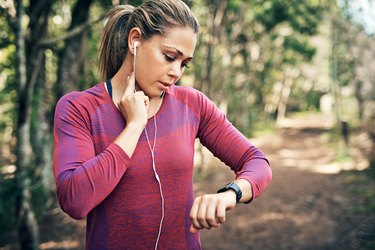
A resting heart rate between 60 and 100 beats per minute is considered normal for most people, according to the American Heart Association (AHA). If your resting heart rate is over 100 beats per minute, you have a type of arrhythmia, or abnormal heart rate, called tachycardia.
It's normal for your heart to beat faster when you exercise. But lots of things can set your heart racing even while you're at rest. Tachycardia can be a response to stress or anxiety, fever, caffeine, or certain medications, says the AHA. Or it might be due to a health condition, such as hyperthyroidism, or heart tissue damage.
Video of the Day
Video of the Day
Tachycardia simply means there is some disruption in the normal electrical impulses controlling the heart's pumping action, the Mayo Clinic explains. Although it doesn't always cause symptoms, the most common is a noticeably faster heart beat, or palpitations, says the Arrhythmia Alliance. You might also experience symptoms such as shortness of breath, dizziness, lightheadedness, fainting or chest pain, Mayo points out. Treatment depends on the type of tachycardia you have. In extreme cases, tachycardia that is left untreated can cause complications that lead to sudden cardiac arrest, according to the AHA.
Read more: Fast Heart Rate and Lightheaded
However, most people with a heart rhythm problem can continue to live normal lives, assures the Heart and Stroke Foundation of Canada. In fact, that may mean adopting certain healthy lifestyle changes, such as becoming physically active.
First Things First: Check with Your Doctor
A key consideration before beginning any exercise program is to determine the right type of activity best suited for an individual's personal health situation. "Anyone with tachycardia should see a physician for clearance before exercising," explains Steven Reisman, MD, director of the New York Cardiac Diagnostic Center, in New York City.
Working with your doctor will enable you to determine if there is an underlying condition, such as anemia or an overactive thyroid, that is causing the arrhythmia, says Dr. Reisman. It's possible that the arrhythmia is part of the heart's normal process, but a thorough examination will confirm whether the tachycardia poses a risk for more serious health problems.
"It is especially important to rule out any type of heart problems," Dr. Reisman says. "An evaluation should be done, including blood tests, EKG and possibly other heart tests, to rule out any abnormal condition. Once cleared by the physician, it would then be okay to exercise as long as the individual does not have symptoms such as chest pain, shortness of breath or dizziness while exercising." If any of these symptoms occur, stop the activity and seek medical attention if they do not resolve with rest.
Ready, Set, Find Your Groove
Exercising for 150 minutes a week — 30 minutes on each of five days, for instance — is the recommendation of the U.S. Department of Health and Human Services and the AHA. Incorporating regular doses of physical activity into each day will help you to feel better physically and mentally. Even if you can't do all 150 minutes a week right away, take small steps and increase activity as you progress. Park a little farther away from the entrance of stores where you shop. Take the stairs instead of using the elevator. Meet a friend to walk around the mall or a local park. You don't have to run a marathon to be moving toward good health.
Remember that exercise comes in all types of packages. You have options in a variety of settings — the gym, a yoga or barre studio, trails at the park or the sidewalk in your own neighborhood. Brisk walking, swimming and bicycling are potential options, says Dr. Reisman.
Talk with your doctor to confirm your maximum heart rate and your target heart rate, which ranges between 50 and 85 percent of the maximum rate, according to the AHA. "One formula to determine 100 percent of maximal heart rate is age dependent," explains Dr. Reisman. The formula looks like this: 220 ‒ your age = maximum target heart rate in beats per minute (bpm). For example, for a 50-year-old, it would be 220 – 50 = 170 bpm. From that number, you'd calculate your target range, in this case between 85 and 144 bpm. However, he cautions, "This is only a rough guide and must be individualized depending on the physical condition of the person."
Read more: What Is a Good Exercise Heart Rate?
The type of exercise you do depends in part on the type of arrhythmia you have, according to Penn Medicine. You might have to take more care than others to prevent undo stress on the heart, but that doesn't mean you should avoid physical activity. Cardio and yoga might be great options, says Penn Medicine, Just but be sure to speak with your doctor to come up with an appropriate plan to help you stay physically active.
- American Heart Association: “Know Your Target Heart Rates for Exercise, Losing Weight and Health.”
- AHA: “Prevention and Treatment of Arrhythmia”
- AHA: “American Heart Association Recommendations for Physical Activity in Adults and Kids”
- Mayo Clinic: "Tachycardia"
- AHA: "Tachycardia: Fast Heart Rate"
- Arrhythmia Alliance:"What Is Tachycardia?"
- Heart and Stroke Foundation of Canada: "Arrhythmia"
- U.S. Department of Health and Human Services: "Physical Activity Guidelines for Americans"
Is this an emergency? If you are experiencing serious medical symptoms, please see the National Library of Medicine’s list of signs you need emergency medical attention or call 911.